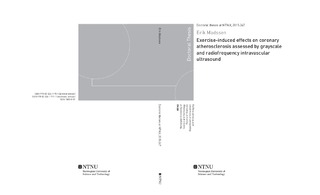| dc.contributor.author | Madssen, Erik | |
| dc.date.accessioned | 2016-01-14T08:37:01Z | |
| dc.date.available | 2016-01-14T08:37:01Z | |
| dc.date.issued | 2015 | |
| dc.identifier.isbn | 978-82-326-1191-1 | |
| dc.identifier.issn | 1503-8181 | |
| dc.identifier.uri | http://hdl.handle.net/11250/2373742 | |
| dc.description.abstract | Coronary atherosclerosis is a leading cause of morbidity and mortality worldwide. Physical
inactivity is an independent risk factor for coronary artery disease, and physically active
patients have an improved prognosis compared to sedate patients. Although the clinical
relationship between exercise and cardiovascular health is convincing, the pathophysiological
mechanisms responsible for improved outcomes in this large patient group are largely
unknown.
In a randomized controlled trial, we assessed exercise-induced effects on coronary
atherosclerosis in 36 patients with established coronary artery disease undergoing stent
implantation and optimal medical therapy. Patients exercised for 12 weeks, either following
an aerobic interval training protocol, or performing moderate continuous exercise. Coronary
atherosclerosis was assessed by grayscale and radiofrequency intravascular ultrasound,
quantifying both plaque geometry and tissue characteristics. Our main findings were that with
both exercise protocols there was a significant reduction in necrotic core (≈ 3 %) and a strong
trend towards a reduction of plaque burden (≈ 10 %) in non-stented coronary segments and in
separate atheroma lesions. There were no differences between exercise groups.
In a post-hoc analysis of data from the randomized controlled trial, we assessed clinical
factors at baseline that potentially were associated with a reduction in necrotic core and
plaque burden at follow-up. We found a strong association between the clinical presentation
of disease and necrotic core volume reduction after aerobic exercise (p=0.011). The
association was in favor of patients with stable coronary artery disease, and necrotic core
volume reduction was much more frequent in these patients (17/18) than in patients with
unstable coronary artery disease (8/18). There were no significant associations between any
clinical baseline explanatory variables and plaque burden reduction at follow-up.
In a third study conducted within a subgroup of patients included in the randomized
controlled trial, we assessed the reproducibility of intravascular ultrasound data acquisition in
stented coronary arteries. This was performed by repeating the intravascular ultrasound
pullback twice at the same time-point, thus simulating data collection in a serial imaging
study. Our main finding was that the inter-pullback reproducibility of geometrical data was
very good for non-stented segments with relative differences between pullbacks < 5 %. For
stented segments reproducibility was poorer, though acceptable, and < 10 %.
Taken together, the data presented in this thesis strengthens the scientific evidence for
beneficial exercise-induced effects on coronary atherosclerosis, not only with respect to
atherosclerotic burden, but also with respect to plaque vulnerability. Furthermore, exerciseinduced
effects on coronary atherosclerosis may be more beneficial in patients with stable
coronary artery disease compared to patients in the early phase after an acute coronary
syndrome. Finally, serial intravascular ultrasound imaging in stented coronary arteries seems
to be associated with a variability of 5–10 % attributed to the acquisition of images itself,
which may have implications for the design of future serial stent studies. | nb_NO |
| dc.language.iso | eng | nb_NO |
| dc.publisher | NTNU | nb_NO |
| dc.relation.ispartofseries | Doctoral thesis at NTNU;2015:267 | |
| dc.relation.haspart | Paper 1:
Madssen, Erik; Moholdt, Trine Tegdan; Videm, Vibeke; Wisløff, Ulrik; Hegbom, Knut; Wiseth, Rune.
Coronary Atheroma Regression and Plaque Characteristics Assessed by Grayscale and Radiofrequency Intravascular Ultrasound After Aerobic Exercise. American Journal of Cardiology 2014 ;Volum 114. s. 1504-1511
<a href="http://dx.doi.org/10.1016/j.amjcard.2014.08.012" target="_blank"> http://dx.doi.org/10.1016/j.amjcard.2014.08.012</a>
The article is reprinted with kind permission from Elsevier, sciencedirect.com | |
| dc.relation.haspart | Paper 2:
Madssen, Erik; Videm, Vibeke; Moholdt, Trine Tegdan; Wisløff, Ulrik; Hegbom, Knut; Wiseth, Rune.
Predictors of beneficial coronary plaque changes after aerobic exercise. Medicine & Science in Sports & Exercise 2015 ;Volum 47.(11) s. 2251-2256 - Is not included due to copyright available at
<a href="http://dx.doi.org/10.1249/MSS.0000000000000672" target="_blank"> http://dx.doi.org/10.1249/MSS.0000000000000672</a> | |
| dc.relation.haspart | Paper 3:
Madssen, Erik; Jakala, J; Proniewska, K; Kulaga, T; Hegbom, Knut; Wiseth, Rune.
Reproducibility of grayscale and radiofrequency IVUS data acquisition in stented coronary arteries. Scandinavian Cardiovascular Journal 2014 ;Volum 48.(5) s. 284-290
- Is not included due to copyright available at
<a href="http://dx.doi.org/10.3109/14017431.2014.942873" target="_blank"> http://dx.doi.org/10.3109/14017431.2014.942873</a> | |
| dc.title | Exercise-induced effects on coronary atherosclerosis assessed by grayscale and radiofrequency intravascular ultrasound | nb_NO |
| dc.type | Doctoral thesis | nb_NO |
| dc.subject.nsi | VDP::Medical disciplines: 700::Clinical medical disciplines: 750 | nb_NO |

